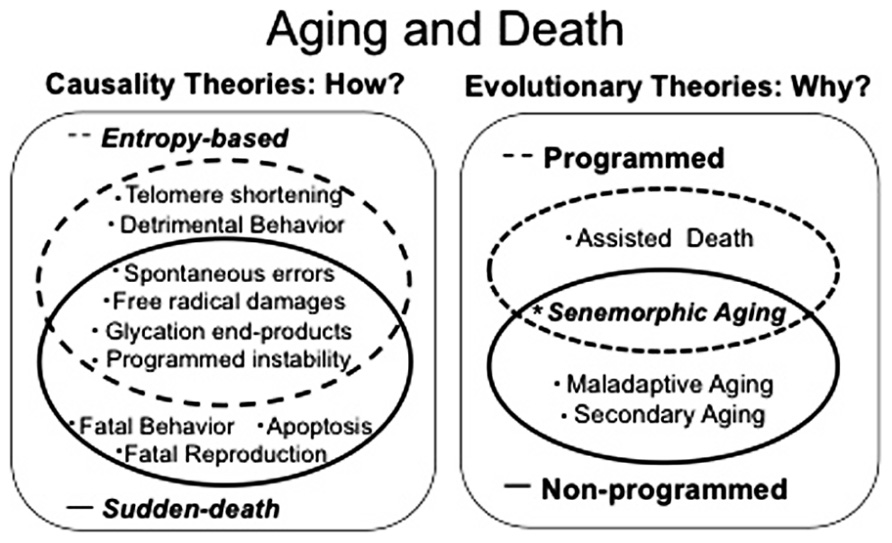The unavoidable question this raises is why are you spending
untold amounts on a project that flies in the face of the basic fact
of the human condition, the existential certainty of aging and death.
To which the unavoidable answer is another question: Who the hell
else is going to do it? Google. Can it be done with probabilistic
efficacy? Yes. Are others doing it? Yes. Do you get anything for
self-risk? Yes. Will you succeed if a failure? Yes. TPE will likely
boost some things. Does Aging theory matter? NO! No attempt by me to
build on things not derived for empiricist me.
Since I offer self as guinea-pig, safety is not the only concern.
Clearly I am expecting something in the efficacy spectrum to benefit me,
as I have detailed earlier. An important issue is likelihood of
favorable outcome and marginal outcomes that will collectively
benefit me even if the main goal is not met. Theory of Information is a
new Paradigm says senolysis is similar to garbage-collection that I
happen to relate to, despite what practitioners know this, will not
be into aging. That is a new paradigm for senolytic drugs, selecting
the goals of GC and their cleanup. There seems to be no need to
recycle and reuse senescent cells, given that NBE proteins that are
eliminated, are all back to their pre-NBE VALUES IN 48 HOURS (AMBAR).
Multiple AMBAR procedures with week gap are fine.
I admit to being a novice in basic bio step but not in macro
ideas.
Start

|
Programmed vs.
Non-Programmed
Aging Theory
Controversy
|
What are the main scientific theories of aging?
Aging theories fall into four main categories, programmed and
non-programmed, entropy based and sudden death.
Sudden death is a quantum physics concept. Here it means telomere shortening to limit.
Entropy based theories are those that assume the growing chaos eventually has no external sink.
A programmed theory of biological aging also known as
adaptive aging, active aging, or aging-by-design
proposes that organisms are designed to age and have a limited life
span and that aging is purposely caused or allowed by a genetic
program similar to the one that controls the development and growth
of an organism. According to this concept, aging is an adaptation
in that it is an organism design feature that was selected by the
evolution process because it benefited the organism. Because a
limited life span conveys benefit, organisms can possess potentially
complex evolved systems that actively regulate life span.
Non-programmed, also known as non-adaptive or
passive aging theories contend that aging is the passive
result of an organism's inability to better withstand deteriorative
processes and that aging has no evolutionary purpose or benefit.
Aging is a defect not a feature of an organism's design. Some
non-adaptive aging theories contend that aging is an adverse side effect of some beneficial function such as reproduction or
cancer prevention that aids the organism in early life at the expense
of aging in later life.
Isn’t aging known to result from generic deteriorative
processes such as oxidation, wear, or other accumulated molecular
damage?
Processes similar to those that cause gradual deterioration in
machinery or exterior paint also operate in living organisms.
However, it is known that living organisms possess many maintenance
and repair functions that act to counteract deterioration. In
addition, generic deteriorative processes cannot be the entire
explanation for aging because very similar species, possessing very
similar biochemistry (with presumably similar exposure to
deterioration), have very different life spans. According to one
programmed aging concept, the aging mechanism purposely discontinues
or slows the maintenance and repair functions at a species-specific
age to result in the observed species-specific life spans.
Isn’t programmed aging incompatible with Darwin’s theory of
evolution? Doesn’t evolution favor development of
characteristics that benefit an organism’s ability to live
longer and breed more?
Yes, programmed aging is incompatible with traditional
evolutionary mechanics and requires an evolutionary mechanics theory
that allows for a slightly expanded definition of “benefit.”
However, a number of other observed organism characteristics also
appear to conflict with classical theory. This led to development of
four different types of proposed adjustments to classical
evolutionary mechanics theory since 1962. These alternative theories
support programmed aging. The alternatives are: group selection
theories, kin selection theories, evolvability theories,
and gene-centered evolutionary mechanics theories. Note that
there is no scientific disagreement with the idea that evolution has
occurred and that current species are descended from different
earlier species. The scientific disagreement centers around details
of how evolution works, the evolutionary mechanisms and processes.
What possible “benefit” could a purposely limited life span
produce?
Different theorists following the programmed aging concept have
developed theories proposing many benefits in the following
broad categories: First, that a purposely limited life span increases
the chance for group survival (e.g. kin, herd, larger population,
even species) and thereby reduces the chance of extinction. Second,
that a limited life span enhances the ability of a species or
population to evolve or adapt or allows it to adapt more rapidly to
changes in its environment producing a competitive advantage. Aging
or other design-imposed life span limitation is obviously adverse
from the viewpoint of an individual organism. Theorists generally
agree that an organism’s evolutionary need for additional life span
declines following the age at which it is first capable of
reproduction.
How do programmed aging theories compare to non-programmed
theories of aging?
Non-programmed (non-adaptive) theories (mostly developed prior to
1962) fit with classical evolutionary mechanics while programmed
(adaptive) theories provide a better fit with observational evidence
but require one of the newer alternative evolutionary mechanics
theories. Recent observations such as “aging genes” have added to
supporting empirical evidence and resulted in increased interest in
programmed theories. The choice of non-programmed vs. programmed
aging theory is consequently essentially a choice between believing
traditional evolutionary mechanics theory against observational
evidence or believing observational evidence against traditional
mechanics but with the support of the newer alternative mechanics
theories. There are multiple programmed aging theories that differ in
detail and there are also multiple competing non-programmed theories.
Is programmed aging biological suicide?
Programmed aging could be considered a form of biological
suicide. However, some animals and plants die suddenly following
reproduction rather than from gradual deterioration and represent
more explicit instances of biological suicide. Examples include
octopus, salmon, and even some mammals, the male marsupial mice. Such
instances of acutely self-limited life span would also fit programmed
aging theories that propose that a species-specific limited life span
generally conveys benefit. Some programmed aging theorists contend
that gradual aging conveys additional evolutionary benefit relative
to sudden death.
What is the history and status of the programmed vs.
non-programmed aging argument?
At some level this controversy has existed for the 150 years since
Darwin’s evolutionary mechanics theory was published in 1859. Prior
to Darwin, there was no reason to suspect that life span was a
characteristic whose origin differed from that of other
characteristics that varied widely between species. The conflict
between the survival-of-the-fittest concept and life span
observations was immediately noticed following publication of
Darwin's book On the Origin of Species.
The first formal programmed aging theory was a “programmed
death” theory published in 1882 by German biologist August Weissmann. Additional formal programmed aging theories based on group
selection and evolvability appeared following publication of those
alternative evolutionary mechanics theories in 1962 and 1995.
Recently, the trend has been toward increasing scientific evidence
(such as aging genes) supporting programmed aging. Concurrently,
scientific confidence in traditional evolutionary mechanics has
declined. However, most gerontologists and other medical researchers
still believe in non-programmed (non-adaptive) aging.
Why should we care?
About 75 percent of all deaths in the U.S. and other developed
countries now result from age-related conditions such as cancer,
heart disease, and stroke. In effect, aging is the most important
cause of these diseases. Understanding the aging process is therefore
essential to understanding, preventing, and treating the age-related
diseases. Although highly associated with aging, these diseases
kill or injure many relatively young people and are the target of
much or even most medical and pharmaceutical research. Programmed
aging theories suggest different and additional approaches in
prevention and treatment of age-related conditions relative to
non-programmed theories.
End

|
Programmed vs.
Non-Programmed
Aging Theory
Controversy
|





